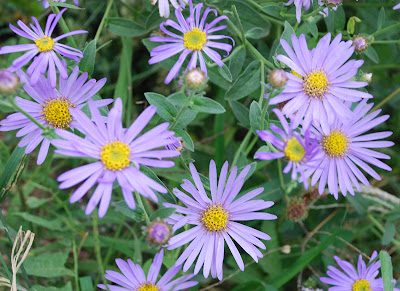One of the calmest and most blending of colors, the violets, lavenders and purples of the (mostly) shade garden suggest cool thoughts even on the hottest of summer days. Although violet-purple is a common flower color in the spring, it is surprising to add up all the lavender-hued flowers throughout the growing season:
One of the earliest of spring bloomers, Sweet Violets, Viola Odorata, grow and spread in my lawn, untouched by the lawnmower blades. These little beauties seem to like the sun, then disappear as it grows warmer. Pick a few of them to enjoy the scent, but the fragrance is short-lived, since the ionones, or rose ketones that give violets their scent, will numb your nose!
I tried many photos of this plant, but finally had to get down flat on the ground to get a decent shot.
Bigger and more aggressive than the sweet violets, the Viola Riviniana, dog-violet, or the more harmonious-sounding Wood Violet, spreads its lovely color every nook and cranny and lawn and empty patch of soil it can fling its voluminous seeds to. These form clumps that are hard to remove! But we forgive them in the spring, just to see that color.
Purple rock cress, the spring Aubrieta that forms a mat of flowers accompanying narcissus and daffodil. The foliage makes a nice tidy green ground cover the rest of the season.
Common violas, which have intermingled and hybridized and flung themselves around the spring border with delight. These miniature lavender pansies grew between rocks in my driveway all summer long, fortunately shaded and well watered during the heat of the day.
Campanula, the bellflowers that form such interesting rock garden and border plants.
Lilacs, queen of the late spring garden
Salvia and Lavender, two of the spiky purple plants. These are reliable in hot dry weather with a long season of bloom.
Velvety royal purple iris multiply quickly and form tight dense rhizomes. Since these are sun-loving plants, and these darker shades need the bright light of mid-day to photograph to capture the color intensity, it is often difficult to photograph them without having problems with brightness and contrast. These were taken on a cloudy day.
Purple cardinal flower, Lobelia Cardinalis, likes its feet wet and filtered shade in the afternoon. These form spectacular clumps of tall spikes that need staking, or else they fold up accordion-fashion along the ground.
Adenophora lilifolia, the often-weedy Ladybells give much-needed color to the late summer shade garden. They are easy to pull up once they bloom, when the leaves wilt and turn brown in a rather unappealing way. A slender, tall plant like this is difficult to photograph since the flower color doesn't stand out. This photo was adjusted for color saturation.
Purple spires of the butterfly bush. Cut these bushes down to the ground in the spring like a large perennial. These grow in filtered shade for me. Another plant that is hard to do justice to in a photograph, especially the taller varieties.
Aster Frikartii, with some of the largest, most daisy-like blooms of all the perennial asters. Well-behaved with an eye-catching color that blends with every other color. Blooms for several months in later summer in full sun. A prime perennial plant.
Common perennial aster that blooms in September and beyond. These plants cross-pollinate and pop up all over the sunny border in little green shrubs that eventually form a sea of lilac-pink, pink, lavender, and darker purple-blue. Cut them back half way in mid-June to keep them from getting completely out of control. Perennial asters can be the mainstay of the autumn garden, often blooming long past first frost, and growing where chrysanthemums are too tender to endure.
I've tried to grow the quilly lavender-blue fleabane Erigeron for a number of years now, and it's finally made itself at home in my front border in semi-shade. With a long blooming season, a nice-looking, if somewhat floppy plant, perfect, fat little yellow centers, and this pretty blending color, it was worth the effort.






















































